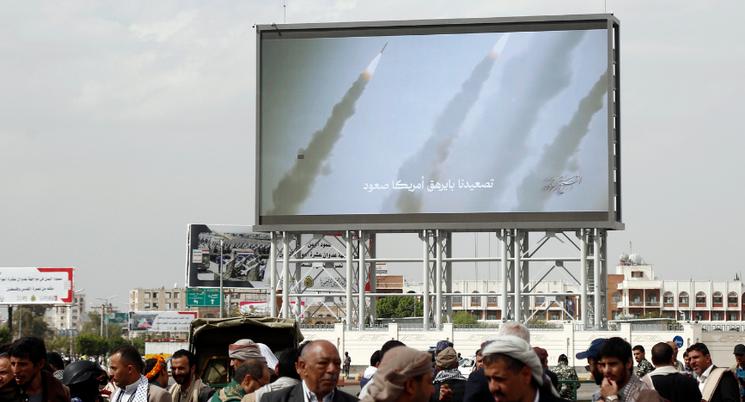
Made in Yemen? Assessing the Houthis’ arms-production capacity
On 15 March, the United States returned to launching significant airstrikes aimed at degrading the Houthis’ military capabilities and bolstering freedom of navigation through the Red Sea and Gulf of Aden. President Donald Trump, in comments on social media, identified Iran as continuing to enable Houthi attacks.
Trump’s comments play into a long-standing debate on the extent to which the Houthis operate as an instrument of Iranian policy. While some describe the group as a mere proxy, reliant on Iranian weapons transfers, others emphasise its political autonomy and capacity for local arms production. Houthi command and decision-making structures remain opaque, making it difficult to assess the degree of political and operational influence Iran exerts. However, the relatively well-documented nature of the Houthi missile and uninhabited-aerial-vehicle (UAV) arsenal, employed in attacks against Israel and in the anti-shipping campaign in the Red Sea and Gulf of Aden, offers insight into the material dimension of the relationship.
Going ballistic
Iran has a long-standing pattern of transferring complete missile and rocket systems to non-state partners and also of enabling localised production among these groups. Since at least the late 2000s, Tehran has supported domestic manufacturing by designing systems tailored for local assembly and providing technical training, production machinery, and key components such as guidance kits and specialised parts. These have been documented in Gaza, Iraq, Lebanon and Syria.
In the case of the Houthis, United Nations investigations into recovered missile remnants and seized propellant-precursor materials provide evidence that Iran has transferred missile-production technology.
The complexity of missile manufacturing, however, increases significantly with range and size. Relatively simple artillery rockets and close-range ballistic missiles (CRBM, which have a range of only 50–300 kilometres) can be produced with limited industrial capacity, as shown by Palestinian groups in Gaza and Hizbullah in Lebanon. Medium-range ballistic missiles (MRBMs), by comparison, are complex systems produced only by a handful of states that have the requisite defence-industrial base.
This divergence appears to be reflected in the composition of the Houthi missile inventory. At least some of the group’s CRBMs, with ranges of up to 200 km, are probably manufactured domestically, though critical components, including guidance systems, are probably still sourced from Iran. These could include close-range anti-ship ballistic missiles (ASBM) such as the Faleq, Mayun and al-Bahr al-Ahmar. Notably, the Mouhit ASBM appears to be a conversion of a legacy RS-SA-2 (S-75 Dvina) surface-to-air missile system, originally a Soviet design, repurposed with Iranian guidance technology.
Medium-range ballistic missiles (MRBM) used for strikes against Israel, however, are almost certainly supplied directly by Iran. Both the solid-propellant MRBMs used by the Houthis, the Palestine 1 and 2 (derivatives of the Iranian Kheibar Shekan or Fattah) and their liquid-propellant MRBMs such as the Zulfiqar (a rebranded Iranian Rezvan) appear too complex for local Yemeni production.
The status of short-range ballistic missiles (SRBM, which have a range of 300–1,000 km) such as the Iranian Fateh-110, anti-ship variants of which have been employed in the Red Sea, is less clear. These systems are more complex than short-range artillery rockets but remain less sophisticated than MRBMs. Iran has previously sought to localise production of the Fateh-110 for Hizbullah in Syria, potentially establishing a precedent. While it remains more likely that the Houthis are importing these missiles ready-made, partial local production cannot be ruled out.
Cruise control
While the Houthis possess some local manufacturing capacity for ballistic missiles, land-attack and anti-ship cruise missiles (ASCMs) appear to be supplied entirely by Iran. Critically, the group is not assessed to have the capability to produce the small turbojet engines required for these systems, nor the active radar-homing seekers used in anti-ship variants. Although it cannot be ruled out that the Houthis have begun producing certain simpler components of the Quds (Paveh) land-attack cruise missile, such as composite airframe parts, seizures related to ASCMs have involved complete systems shipped in disassembled form, with Yemen-based activity limited to final assembly.
UAVs
Independent local-production capabilities appear most advanced in the domain of simple UAVs. In particular, the Sammad 3 (KAS-04) one-way attack UAV (OWA-UAV), representing the low-tech end of Iran’s long-range OWA-UAV portfolio, has been used on a large scale in land-attack operations against Israel and, in loitering variants, against maritime targets in the Red Sea and Gulf of Aden. Interviews with Western officials, as well as the low quality of manufacturing observed on recovered examples, strongly indicate that these are manufactured inside Yemen.
While key components related to guidance, control and propulsion even for simpler UAVs cannot be produced domestically, many of these are commercially available, enabling the Houthis to procure them independently from Iran where necessary. The use of Chinese-made DLE-170 engines by the Sammad 3 is one such example. Nevertheless, previously recovered Sammad airframes have also included Iranian-made components, such as gyroscopes.
More advanced one-way attack UAVs in Houthi service, such as the Shahed-131, Shahed-136 and long-range Yaffa, incorporate a higher proportion of Iranian-supplied systems. These include more powerful engines that are less accessible on the open market and, in the case of the Shahed series, more complex composite-airframe components.
Conclusion
Despite incremental advances in domestic arms production, particularly in UAVs and CRBMs, the Houthis remain dependent on Iran for key technologies and advanced capabilities. While Tehran’s support has, in some areas, evolved from the direct provision of complete systems to enabling localised manufacturing, it remains a critical enabler of Houthi military activity. The group is probably capable of independent innovation in tactics, techniques and procedures (TTPs), and of producing simpler UAV technology. However, Yemen’s limited industrial base and overall development constraints are almost certainly placing significant limits on the local production and further advancement of more complex systems, including MRBMs and cruise missiles. Ongoing US strikes, which are known to be targeting Houthi production sites, are expected to further complicate efforts to expand domestic production of more advanced systems.
Source: iiss








You must be logged in to post a comment.